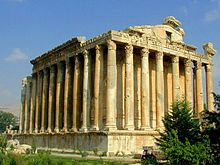Archaeology in Lebanon
Archaeology in Lebanon spans a vast time period, ranging from the Middle Palaeolithic up to the Ottoman period.



Notable findings and sites

Lebanon features several important Paleolithic sites associated with Neanderthals. These include Adloun, Chekka Jdidé, El-Masloukh, Ksar Akil, Nahr Ibrahim and Naame.[1] Jbail is a well-known archaeological site, also known as ancient Byblos (the name assigned by the Ancient Greeks and derived from the word biblio), a Phoenician seaport, where the tomb of Ahiram is believed to be located. An ancient Phoenician inscription on the tomb dates to between the 13th and 10th centuries BCE.[2] Byblos, as well as archaeological sites in Baalbek, Tyre, Sidon, and Tripoli, contain artifacts indicating the presence of libraries dating back to the period of Classical antiquity.[2]
Damage to archaeological sites
During the 2006 Lebanon war, a number of archaeological sites, including world heritage sites, were damaged as a result of Israeli aerial bombardments in Lebanon.[3] A survey of the damage to sites in Lebanon was launched by UNESCO after the international archaeological community, including the director of the British Museum, Neil MacGregor, urged an investigation into the effects of bombing on "one of the planet's most heritage-rich countries."[4] UNESCO's team of experts found that the most serious damage resulting from the conflict was at the world heritage site of Byblos, where an oil spill resulting from the targeting of fuel tanks at the Jiyeh power plant had stained the stones at the base of the port's two Medieval towers, among other archaeological remains on the seashore.[3][4] Mounir Bouchenaki, Director-General of the International Centre for the Study of the Preservation and Restoration of Cultural Property (ICCROM) estimated that it would take twenty-five people eight to ten weeks to manually hand-clean the affected areas, placing the cost of the operation at some 100,000 USD.[3]

The mission also found that the main features of the world heritage site of Tyre, such as the Roman hippodrome and triumphal arch had escaped damage, but that frescoes in a Roman tomb at the site had come loose, likely because of vibrations caused by bombs.[3] It was also reported that the world heritage site of Baalbek was not damaged by bombs, with the exception of the fall of one block of stone and the widening of fissures on the lintels in the temples of Jupiter and Bacchus, likely due to vibrations from nearby bombings.[3] Also damaged by bombs, as noted by the mission, were the souk and some old houses in the Old City of Baalbek that were not part of the property inscribed on the World Heritage List.[3]
At a press conference revealing the results of the survey, Françoise Rivière, UNESCO's Assistant Director-General for Culture, reported on UNESCO's efforts during and after the fighting to draw the attention of both parties to their obligations to spare cultural heritage, as protected by the Hague Convention for the Protection of Cultural Property in the Event of Armed Conflict, to which both Lebanon and Israel are States Parties.[3]
References
Notes
- ^ Kipfer, 2000, pp. 623, 632, 637, 647, 655.
- ^ a b Wedgeworth, 1993, p. 453.
- ^ a b c d e f g "Mission reports on war damage to cultural heritage in Lebanon". UNESCO. September 18, 2006. Retrieved 2008-02-18.
- ^ a b Rob Sharp (2006-09-17). "Bombs shatter Lebanon's Roman legacy". London: The Guardian. Retrieved 2008-02-18.
Bibliography
- Kipfer, Barbara Ann (2000). Encyclopedic Dictionary of Archaeology. Springer. ISBN 0306461587.
- Wedgeworth, Robert (1993). World Encyclopedia of Library and Information Services. ALA Editions. ISBN 0838906095.
